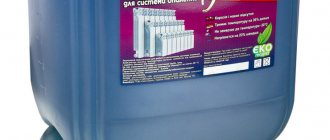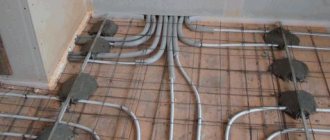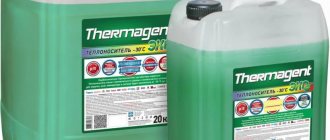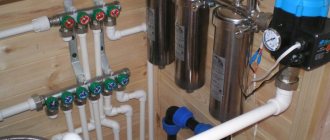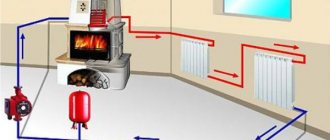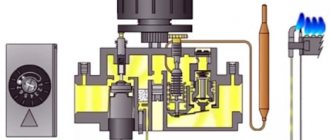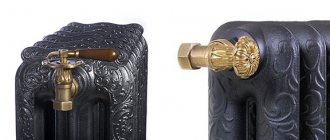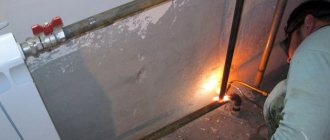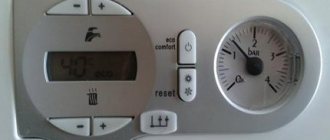Innovative technologies and materials make it possible to improve the basic elements that create comfort in the home, in particular the heating system. Today, the consumer is able to increase its functionality and reliability. But some of the innovations that are being introduced to improve the performance of the heating system are associated with risks. Even basic things can threaten her work. For example, water. Some homeowners choose non-freezing liquids for heating systems, and this, as practice has shown, is much more rational.
Antifreeze for living quarters
Non-freezing liquid for the heating system - antifreeze, antifreeze, but having a completely different composition than products for cars. The main property of this household product is that it does not transform into ice when the temperature drops even to -60 °C (the substance simply thickens).
Any antifreeze for heating systems, for example, Warm House, is produced according to the same principle. The product contains:
- alcohol or glycol;
- base active ingredient;
- inhibitory components that protect against rust;
- additives that are responsible for the properties of antifreeze.
Anti-freeze for the heating system of a country house - an alcohol-based product. The glycol alcohol substance is not dangerous, but other components of the liquid can harm people:
- glycerol;
- ethylene;
- propylene.
The area of application of the product for the home heating system depends on the constituent substances. It is not recommended to use a product containing ethylene.
Liquid containing ethylene should not be allowed into the heating system of a building where people live permanently. This product is very poisonous, and if it gets on the skin, it will cause tissue burns. When an ethylene-based antifreeze liquid gets inside the body (both in liquid and gaseous states), severe complications develop, including death.
A low-quality antifreeze product and the familiar antifreeze for cars, which sometimes unknowing people pour into the heating line of a building, is produced precisely with ethylene glycol. If there is even an insignificant risk of people coming into contact with ethylene, it is correct to refuse its use in systems:
- vapors from an open expansion tank;
- leak;
- mixing into the DHW circuit in 2-circuit boilers.
It is prohibited to use ethylene antifreeze for systems where a 2-circuit boiler is used as a heating element.
Antifreeze based on propylene is absolutely non-toxic - it can be safely used for heating systems. This does not mean that if it gets on the skin or even inside the body, no problems will arise. Still, this is a chemical substance and it is alien to the body. But it will not lead to death or severe damage to internal organs. This non-freezing liquid can be safely poured into the home heating system.
Antifreeze based on glycerin has been used in circuits since the 50s of the 20th century and is used today. Unlike the two heating compounds listed above, glycerin liquid does not dry out the rubber, but, on the contrary, promotes restoration and renewal. Therefore, the rubber seals of the system will not deteriorate.
How can antifreeze harm you?
Ethylene glycol is toxic. Any leakage or careless handling of the liquid can seriously harm the health or even threaten the lives of people and pets.
Adding water to antifreeze improves a number of its characteristics - viscosity, heat capacity - but increases the freezing point of the coolant. The higher the concentration of antifreeze, the more serious the effect on the metal elements and seals of the system. The latter can dissolve under the influence of concentrated antifreeze, which eventually leads to leaks.
To reduce the effects of corrosion, the manufacturer adds inhibitors to antifreeze. Sometimes you have to buy them separately and mix them yourself. But if you overdo it with the proportion of water in the coolant, the effectiveness of the additives decreases and the risk of corrosion increases. This happens both through the fault of the user - inaccurate calculations during dilution - and as a result of replenishment of the coolant during operation.
Antifreeze should not come into contact with zinc, which may be present in the coating of pipes and fittings. As a result of their interaction, an insoluble precipitate is formed, which gradually destroys the heating system. Manufacturers of boilers and other heating system components (pumps, connections, filters) are likely to refuse a warranty when using antifreeze as a coolant.
While there are not so many deposits, the situation can be corrected. To do this, you need to flush the heating system.
Energobyt Service → Services: Heating system flushing
Characteristics of anti-freeze
The behavior of the product in the heating system is affected by the quality of the additive elements and the conditions of use. Regardless of which base material is included in the glycol base, all fluids protect against corrosive formation and foaming.
If there are no additives, it is harmful to use an antifreeze product for home use. Such antifreezes foam, especially those based on glycerin. Foam is a substance containing air. Oxygen causes circulation problems, forms air pockets, and can also cause water hammer in the heating network.
Additives have a time resource. When a certain period of time passes, they disintegrate into molecules. A precipitate forms and acid is released. This means that nothing can neutralize the aggressiveness of the antifreeze liquid for the heating system of the building. In addition, the situation is worsened by the formation of acid. The terms of application of the compositions in years are as follows:
- ethylene based – 5;
- propylene – 5;
- on glycerin – 10.
Temperature matters. When the temperature of the coolant increases to 90 °C, the non-freezing liquid for the heating system begins to split and lose its qualities. This happens if the boiler is not started correctly after a long period of inactivity, as well as due to errors when installing equipment.
For example, when a heat exchanger is installed in a standard stove. Often homeowners arrange it so that it is in contact with open fire. Do not use antifreeze in the oven - this is strictly prohibited. It is necessary that there is a layer of brick between the exchanger and the fire. This way the heat will dissipate efficiently, and the non-freezing liquid for the heating system will not heat up too much.
Properties affected by the quality of filler components:
- viscosity;
- fluidity;
- heat conductivity;
- thermal expansion;
- density.
The better the additive elements of the non-freezing liquid for the heating system, the higher these properties are. This means that they are as close to the characteristics of water as possible. The level of thermal expansion should be low. The volumetric expansion of non-freezing heating fluid is higher than that of water - this is important to take into account when filling the system.
The thermal conductivity of antifreeze is less than that of water. For glycerin products it is the lowest - 85%, for other antifreeze products - 90%. The difference is insignificant.
Antifreeze is 50% more dense and viscous than water. These properties negatively affect circulation. To improve the movement of the coolant along the circuit, powerful pumping equipment is required. It would be nice to assemble a heating network from pipes with a large diameter. For example, when it comes to polypropylene pipes, section 32 is suitable.
Circulation pump
Antifreeze liquid for the heating system is more compacted and viscous, but it has a high level of fluidity. Thanks to this, it is able to move where water cannot pass due to surface tension. Therefore, if there are microscopic cracks and even micro-holes, then antifreeze will leak in this place.
Therefore, often, after water has circulated in the circuit and antifreeze has been poured into it, leaks are found. Most often, micro-holes or cracks are found in the following places:
- pipeline joints;
- areas between radiators;
- areas for connecting additional components;
- directly the boiler tank.
Comparison of technical and operational parameters of heating antifreezes and water
It is worth pointing out that anti-freezing for the heating system is not the only option for solving the problem of possible freezing of the pipeline and boiler in the event of an emergency, namely a lack of electricity or a cessation of fuel supply in the form of gas.
The way out of the first situation is to use spare gasoline generators; if there is no gas, purchase a boiler with two types of fuel in advance.
That is, any user is faced with a choice - to use ordinary water with various methods of insurance against freezing or to use antifreeze. In any case, it is useful for him to have the following comparative information of these two types of coolants:
Availability. You can always get clean water by turning on the tap in your house or drawing it from a well or borehole. Antifreeze must be purchased in a retail chain, wasting time, paying for transportation costs or delivery.
Which antifreeze to choose
If the user wants to use an antifreeze liquid, then when choosing it, you should not focus only on cost. Antifreeze for the home is a product presented on market shelves in a large assortment.
The “Warm Home” product, produced by a Russian manufacturer, is popular. Some homeowners use this type of anti-freeze. Its cost is reasonable. The main advantage is that it has improved operating properties. It can not be changed in the heating system for 5-10 seasons.
Antifreeze “Warm Floor” is the most popular on the Russian market
Prices for antifreeze liquids vary, so each homeowner can choose the right one. The assortment expands every year. They are made from high-quality raw materials and are safe for the body. The non-freezing liquid Warme Hydro has proven itself well, as well as Galan, Thermagent ECO -30, BOILER -65 oC. A specialist from a specialized store will always help you with your choice.
It is forbidden to fill the heating network of the house with car antifreeze. It contains components that are not suitable for residential use.
Reasons why boiler manufacturers refuse to use antifreeze
(Slovakia) declares that it is not responsible for the consequences caused by the use of antifreeze. Cast iron boilers manufactured by the company are not designed to interact with non-freezing liquids. Vaillant (Germany) is even more categorical, declaring that non-freezing liquids cannot be used in wall-mounted boilers! As for other manufacturers, everything is more confusing here. Some of them inform about the use of special paronite gaskets in the design of boilers, which are suitable for many types of antifreeze. However, the other side of the coin is not advertised: difficulties with seals are not the only problem when using antifreeze.
When the coolant is not used
Antifreeze sometimes cannot be used. Recommendations:
- When the heating network of a building is based on a 2-circuit boiler, no antifreeze is used. The substance may penetrate into the building's water supply circuit.
- Antifreeze is prohibited in open heating networks. The coolant will steam and the homeowner will have to top it up regularly.
- It is forbidden to pour the product into a system that consists of a galvanized pipeline. This provokes a change in the chemical composition of the antifreeze and its loss of its performance qualities.
- Antifreeze, when compared to water, has a lower heat capacity. If it is to be used as a heat carrier, then powerful radiator elements must be used when organizing the heating network.
- The antifreeze composition is viscous, so you cannot do without a strong circulation pump.
If the homeowner 100% decides to add antifreeze, then it is better to prefer products based on propylene or glycerin. The former are expensive, the latter have the lowest thermal conductivity and weigh more. Propylene glycol products are more innovative, which is why many people purchase them. Ethylene glycol liquids are prohibited for the home, since the risk of contact with residents is high, and maintaining a network with a toxic substance is a big problem.
How to choose a coolant for heating
Drawing up a wiring project and installing heating in a private house should be carried out together with the choice of the type of coolant. The type of liquid selected depends on the boiler power rating and the performance of heating devices, the selection of such an important unit as a circulation pump and the purchase of other materials and components.
If a two-pipe heating system with bottom wiring will be used throughout the winter, then water is considered the ideal choice. At the moment, such a liquid is considered the main coolant. Water can be collected from a well or borehole, and it is absolutely free.
Advantages and disadvantages
Compared to water, the coolant for the heating system has both advantages and disadvantages. The advantages include:
- the liquid is resistant to low temperatures, so the pipes will be in good condition even in severe frosts;
- heats more efficiently than water;
- there is no need to drain the non-freezing coolant when spring comes;
- when used correctly, does not cause allergic reactions and is not harmful to health;
- the cost of insulating heating pipes is lower;
- slow evaporation, so refueling the system is required less often, 1-2 times a season.
The antifreeze composition cannot be heated above 170 °C, it will begin to decompose.
Despite the advantages, home heating fluid has a number of disadvantages compared to water:
- installation of powerful equipment and a pump for the heating system;
- heat capacity is 15% lower;
- the volume of the heating radiator should be 50% larger;
- use only a closed tank.
Fluid deficiencies can be mitigated if heating communications are planned in advance, at the construction stage.
Features of using water as a coolant
From the point of view of heat transfer efficiency, water is an ideal coolant. It has a very high heat capacity and fluidity, which allows it to deliver heat to the radiators in the required volume. What kind of water should I fill? If the system is closed, you can fill it with water directly from the tap.
Yes, tap water is not ideal in composition; it contains salts and a certain amount of mechanical impurities. And yes, they will settle on the elements of the heating system. But this will happen once: in a closed system, the coolant circulates for years, and replenishment with a small amount is very rarely required. Therefore, some amount of sediment will not cause any tangible harm.
Water as a coolant for heating systems is almost ideal
If the heating is of an open type, the requirements for the quality of water as a coolant are much higher. Here, gradual evaporation of water occurs, which is periodically replenished by adding water. Thus, it turns out that the concentration of salts in the liquid increases all the time. This means that sediment also accumulates on the elements. That is why purified or distilled water is poured into open-type heating systems (with an open expansion tank in the attic).
In this case, it is better to use distillate, but getting it in the required volume can be problematic and expensive. Then you can fill in purified water that has been passed through filters. The most critical is the presence of large amounts of iron and hardness salts. Mechanical impurities are also useless, but they are the easiest thing to deal with - several mesh filters with cells of different sizes will help catch most of them.
In order not to buy purified water or distillate, you can prepare it yourself. First, pour and let sit until most of the iron settles. Carefully pour the settled water into a large container and boil (do not cover with a lid). This removes hardness salts (potassium and magnesium). In principle, such water is already well prepared and can be poured into the system. And then top up with either distilled water or purified drinking water. This is no longer as expensive as the initial fill.
Rating of the best non-freezing liquids
TOP 5 antifreezes for the home will allow you to easily choose what you need. If problems arise, you can always contact the manager of a specialized store.
Knowing the advantages and disadvantages, it is important to buy a good heating fluid. The following brands of antifreeze are the most popular among users.
DIXIS-65
Ideal for use in gas and electric boiler equipment of any type of installation. Excellent transfer of heat at external temperatures from -65 °C to +9 °C.
This antifreeze composition is ideal for cast iron, copper, aluminum, and brass heating pipes. Does not damage joints, does not harm pipelines and plastic tanks. Together with the anti-freeze system, a sticker is issued for the heating boiler, where you can see fields for entering the fill date, volume and other details - this is indispensable when maintaining the system.
Experts gave the leading position in the rating to this particular non-freezing liquid, since its crystallization occurs only at -66 °C. This is the best substance for heating lines in northern regions - it will survive severe frosts and keep the pipeline and radiators intact.
When used in regions where the temperature in winter is not lower than -20 °C, the antifreeze liquid is diluted with water 1 to 1 - this is a serious money saving.
Pros:
- fire resistant;
- increased antifreeze rate;
- five-year warranty;
- protection of containers from burglary.
Minuses:
- liquid heat capacity is 10% lower;
- high viscosity;
- cannot be used in galvanized heating pipelines;
- prohibited in boiler equipment with electrodes.
THERMAGENT-65
Domestic liquid produced from German raw materials. The unique technology of Organic Technology is used in production. The antifreeze substance does not contain amines or other toxins. It is poured into boiler systems operating on liquid fuel, gas and current.
According to consumers, the drug does not spoil rubber, sealants and parasites. The manufacturer included additives that prevent the growth of bacteria and foaming, so the heating pipes will remain clean and with high-quality permeability.
The non-freezing coolant is included in the TOP 5, as it has a low level of crystallization at a temperature of -65 ° C, as well as a long service life. It protects against rust for up to ten years and is used for up to twenty seasons without losing its properties. This is more than economical.
Pros:
- raw materials for the production of antifreeze composition for heating are imported from Germany;
- the liquid does not freeze at low temperatures;
- can be bred;
- contains no toxins.
Minuses:
- ethylene is present;
- cannot be used in Galan type heating equipment;
- when combined with water, the quality of rust protection is reduced;
- functions poorly with wood-burning boilers due to overheating.
RODA
Antifreeze liquid from a well-known brand that creates boiler equipment from neighboring countries. The manufacturer also took care of the careful handling of heating systems.
Glycerin-based coolant is one of the safest. Contains an anti-foaming additive. The liquid does not freeze even at -30 °C. It boils after +105 °C, so it is suitable for a larger number of heating lines and equipment.
Contains a fluorescent dye for rapid detection of leaks in pipes and heating radiators. Non-freezing liquid is produced in containers of 10 and 20 kg. It is poured into the system in proportions of 113 kg per 100 liters.
Experts recommend this liquid for heating networks with open circuits, where the expansion tank is not equipped with a sealed lid. The organic antifreeze composition is not dangerous when evaporated. Therefore, this type of heating fluid can be used even in food industry enterprises. The advantage of the coolant is that it is allowed to be used in galvanized pipelines.
Pros:
- service life eight to ten years;
- fire resistance;
- will not harm circulation pumping equipment;
- When switching to this type, there is no need to flush the heating line.
Minuses:
- relatively high price for 10 kg;
- it is forbidden to overheat the liquid;
- cannot be used with non-polar plastic materials.
AMT-300
Antifreeze heating agent from a domestic manufacturer, supplied to the market in barrels weighing 20, 30 or 180 kg. This makes it possible to immediately buy the required volume for your home at an affordable price. It is based on an oily substance with flavorings. Products must undergo catalysis and adsorption for a higher level of purification.
Not suitable for open communication systems. The density of the oil substance is 940 kg/m3, therefore it is suitable for relatively warm climates. Antifreeze from this manufacturer is mainly used in southern regions, where it rarely gets colder than -15 °C.
Antifreeze for heating entered the TOP due to its increased thermal stability when heated and the impossibility of ignition under the influence of high temperatures. The boiling point of the oil is almost +300 oC. Therefore, it is even poured into equipment that runs on solid fuel, but only with powerful pumping units to increase circulation so that the non-freezing coolant does not overheat in the exchanger.
Pros:
- almost zero acidity is gentle on heating system components, rubber, plastic, metal, sealant;
- high-quality fluidity in a heated state;
- high anti-corrosion properties, regardless of the period of use;
- does not accumulate condensation and does not form plaque.
Flaws:
- antifreeze composition is prohibited for open boilers;
- crystallizes at -15°C;
- it is necessary to use powerful pumping equipment.
How to prepare a heating system for filling?
Before filling the heating system with distilled water, you should prepare. This means the following activities:
- Drain the old coolant . Turn off the heating boiler and wait until the temperature drops to room temperature. Then open the drain valve located at the bottom of the circuit and drain the water into a container for later disposal. After the system is completely emptied, open the Mayevsky valve (located at the top) to stabilize the pressure in the pipes.
- Rinse the circuit . This is required to remove all accumulated debris from inside. Why connect a pump, which is used to pump flush water. For these purposes, you can use tap water. Sometimes one cycle is not enough to completely clean the system. The outlet water must be clean.
- The equipment is pressed . Allows you to test the system for leaks before filling it with coolant. It is necessary to create internal high pressure by pumping air or coolant. To do this you will need a mechanical or electric pump.
- Correct defects . Leaks discovered during pressing must be eliminated. If leaks are detected at the joints, then replace the seal. When a pipe leaks, the damaged section is replaced.
- Check the package . When the heating system is closed, you will need to make sure that there are safety devices in place before filling it. First of all, this is a Mayevsky tap, bypasses, a thermometer and a pressure gauge. The absence of something can lead to problems in the operation of the equipment in the future.
Important! Before filling the coolant, it is necessary to flush the system, even if it is just installed.
Where to buy antifreeze for the heating system of a private home
Ours offers a wide and complete range of equipment and components for heating systems. In our online store you can also purchase antifreeze, the use of which guarantees the safety of the heating system in the house and will protect it from freezing. But since this choice has many nuances, our specialists, taking into account all the operational and technical features, will offer the most correct and optimal choice.
When placing an order on the website of our online store “Alfatep”, we definitely recommend using the services of a transport service to deliver the goods to the site. If necessary, to fill the system and start it, you can use the services of an experienced technician who will perform all the necessary operations efficiently and completely safely for your home.
